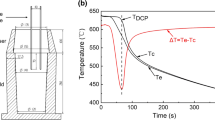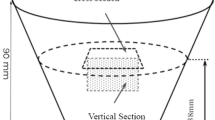Abstract
An approach for selecting alloying elements to control the size of an in situ formed phase is proposed based on a G–D map, which is derived from basic thermodynamic and kinetic principles. The G–D map is divided into four zones. Elements in Zone III are potential refiners whereas those in Zone II should be avoided in processing. When applied to the Mg2Si/Mg system, we find that Sr, P, Sb and Sn refine Mg2Si by increasing the nucleation rate and inhibiting the growth rate. Conversely, Ti, Mn, Zr and V contribute to coarse-shaped Mg2Si by postponing nucleation. The content of alloying elements should be matched with the Si content, and the required amount can be pre-estimated from the G–D map. Mg2Si formed in Mg-Al and Mg-Zn alloy is smaller than that in Mg-Si and Mg-Mn alloy, because Al and Zn suppress the diffusion of Si, particularly at high Si contents. The predictions of this approach are consistent with experimental observations. Hence, the G–D map can provide useful guidance for quantitative phase refinement design.




Similar content being viewed by others
References
1. L. Lu, K. Thong, and M. Gupta: Composites Science and Technology, 2003, vol.63, pp. 627-632.
2. K. Asano and H. Yoneda: Materials Transactions. 2007, vol.48, pp. 1469-1475.
3. S. Thakur, B. Dhindaw, N. Hort, and K. Kainer: Metallurgical and Materials Transactions A. 2004, vol.35, pp. 1167-1176.
4. J. He, B. Jiang, H. Xie, Z. Jiang, B. Liu and F. Pan: Materials Science and Engineering: A. 2016, vol.675, pp. 76-81.
5. E. Schmid, K. Von Oldenburg and G. Frommeyer: International Journal of Materials Research, 1990, vol.81, pp. 809-815.
6. M. Mabuchi, K. Kubota, and K. Higashi: Materials science and technology. 1996, vol.12, pp. 35-39.
7. Y. Lü, Q. Wang, X. Zeng, Y. Zhu, and W. Ding: Materials Science and Engineering: A. 2001, vol.301, pp. 255-258.
8. M. Mabuchi, K. Kubota, and K. Higashi: Scripta metallurgica et materialia. 1995, vol.33, pp. 331-335.
9. M.O. Pekguleryuz and M.M. Avedesian: Journal of Japan Institute of Light Metals, 1992, vol.42, pp. 679-686.
10. Y. Pan, X. Liu, and H. Yang: Materials Characterization. 2005, vol.55, pp. 241-247.
11. G. Yuan, M. Liu, Q. Wang and Y. Zhu: Acta Metallrugica Sinica, 2002, vol.56, pp. 53-58.
X.H. Guo, J. Du, W.F. Li and J.H. Peng: Chinese Journal of Nonferrous Metals, 2010, vol. 20, pp. 24-29.
13. R. Alizadeh and R. Mahmudi: Journal of Alloys and Compounds. 2011, vol.509, pp. 9195-99.
14. A. Srinivasan, U. Pillai, and B. Pai: Metallurgical and Materials Transactions A. 2005, vol.36, pp. 2235-2243.
15. H.Y. Wang, Q. Li, B. Liu, N. Zhang, L. Chen and J.G. Wang: Metallurgical and Materials Transactions A, 2012, vol.43, pp. 4926-4932.
16. M. Yang, P. Fusheng, C. Renju, and S. Jia: Materials Science and Engineering A. 2012, vol.489, pp. 413-418.
17. J.J. Kim, D.H. Kim, K. Shin, and N.J. Kim: Scripta Materialia. 1999, vol.41, pp. 333-340.
18. G. Yuan, M. Liu, W.Ding and I. Akihisa: Materials Science and Engineering: A. 2003, vol.357, pp. 314-320.
19. S.Q. Tang, J.X. Zhou, C.W. Tian and Y.S. Yang: Transactions of Nonferrous Metals Society of China. 2011, vol.21, pp. 1932-1936.
20. K.Y. Nam, D.H. Song, C.W. Lee, S.W. Lee, Y.H. Park, K.M. Cho and I.M. Park: Materials Science Forum. 2006, vol.510-511, pp. 238-241.
21. R.J. Cheng, A.T. Tang, M.B. Yang and F.S. Pan: Materials Science Forum. 2007, vol.546-549, pp. 183-186.
22. Q.C. Jiang, H.Y. Wang, Y. Wang, B.X. Ma and J.G. Wang: Materials Science and Engineering A. 2005, vol.392, pp. 130-135.
23. L. Ye, J. Hu, C. Tang, X. Zhang, Y. Deng, Z. Liu, and Z. Zhou: Materials Characterization. 2013, vol.79, pp. 1-6.
24. H. Yi and Z. Di: Materials Letters, 2003, vol.57, pp. 2523-2529.
25. C.L. Xu, Q.C. Jiang, Y.F. Yang, H.Y. Wang and J.G. Wang: Journal of Alloys and Compounds. 2006, vol.422, pp. L1-L4.
26. A.A. Nayeb-Hashemi and J.B. Clark: Journal of Phase Equilibria, 1984, vol.5, pp. 584-592.
K. Kelton and A.L. Greer: Nucleation in condensed matter: applications in materials and biology, Vol. 15. 2010: Elsevier, Amterdam.
S.E. Offerman, N.H. Dijk, J. Van Sietsma, S. Grigull, E.M. Lauridsen, L. Margulies, H.F. Poulsen, M.T. Rekveldt and S. Van Der Zwaag: Science, 2002, vol. 21, pp. 179-179.
29. I. Maxwell and A. Hellawell: Acta Metallurgica. 1975, vol.23, pp. 229-237.
30. W. Tiller, K. Jackson, J. Rutter, and B. Chalmers: Acta metallurgica. 1953, vol.1, pp. 428-437.
W. Kurz and D.J. Fisher: Fundamentals of solidition, 4th ed., Trans Tech Publication Ltd, Uetikon, 1998, pp. 21-45
32. Y.J. Liang and Y.C. Che: Themodynamical properties of inorganic substances, Northeastern University Press, Shengyang, China, 1993, pp. 153
33. L.S. Darken: Transactions of the Metallurgical Society of AIME, 1948, vol.175, pp. 184-201.
34. J. Chen, T. Fan and D. Zhang: Metallurgical and Materials Transactions A, 2006, vol.37, pp. 2275-2281.
35. J.S. Kirkaldy and D.J. Young: Diffusion in the Condensed State, London Institute of Metals, London, 1987,PP. 233
36. G. Schwitzgebel and G. Langen: Journal for Nature Research A, 1981, vol.36, pp. 1225-1232.
37. T. Fan, G. Yang, and D. Zhang: Metallurgical and Materials Transactions A. 2005, vol.36, pp. 225-233.
38. T. Fan, C. Zhang, J. Chen, and D. Zhang: Metallurgical and Materials Transactions A. 2009, vol.40, pp. 2743–50.
39. H.B. Aaron, D. Fainstein and G.R. Kotler: Journal of Applied Physics, 1970, vol.41, pp. 4404-4410.
40. J.D. Hunt: Materials Science and Engineering, 1984, vol.65, pp. 75-83.
P.D. Quimby, S.Z. Lu, M.R. Plichta, D.K. Visser and K.P. Jacobe: Magnesium Technology 2006, TMS annual Meeting,Texas, 2006, vol. 2006, pp. 535–37.
42. C. Zhang, T. Fan, W. Cao, J. Ding, and D. Zhang: Composites Science and Technology. 2009, vol.69, pp. 2688-2694.
G. Zhang, D.U. Jun, L.I. Wen-Fang, Q. Dou, and T.X. Cai: J. Mater. Eng., 2013, pp. 81–84.
44. Y. Li, W. Tian, Q. Hu and Y. Yan: Special Casting and Nonferrous Alloys, 2007, vol.27, pp.293-297
45. J. Zhang, Z. Fan, Y. Wang, and B. Zhou: Scripta Materialia. 2000, vol.42, pp. 1101-1106.
46. A. Crawley: International Metallurgical Reviews. 1974, vol.19, pp. 32-48.
47. A.K. Niessen, F. De Boer, R. Boom, P. De Chatel, W. Mattens and A. Miedema: Calphad, 1983, vol.7, pp. 51-70.
R.I. Guthrie and T. Iida (1987) The physical properties of liquid metals. Clarendon Press, New York, pp. 47-70
Acknowledgments
We acknowledge the financial support of the National Key Research and Development Plan (No. 2017YFB0703101) and the National Natural Science Foundation of China (No. 51821001).
Author information
Authors and Affiliations
Corresponding author
Additional information
Publisher's Note
Springer Nature remains neutral with regard to jurisdictional claims in published maps and institutional affiliations.
Manuscript submitted October 12, 2019.
Appendix A
Appendix A
1.1 Calculation of the Self-diffusion Coefficient \( D_{i}^{*} \)
The self-diffusion coefficient for binary liquid alloys based on hard sphere theory is given by Reference 36:
where \( l_{i} \) and \( M_{i} \) are the atom radius and molar mass of component i, \( Z_{x} \) is the compressibility factor, and \( C\left( \eta \right) \) is the correction factor.
where \( \rho_{i} \) is the density of component i, which can be obtained in Reference 46 and is shown in Table A2. \( N_{o} \) is the Avogadro number, and \( \eta_{i} \) is the packing fraction, hence:
where T and \( T_{i} \) are the temperature of the liquid melt and the melting temperature of component i;\( \rho_{{m_{i} }} \) is the density of component i at the melting temperature; \( M_{x} \) and \( \rho_{x} \) are respectively the molar mass and the density of the liquid:
From Eqs. [A2] through [A7], the self-diffusion coefficient of \( D_{\text{Si}}^{*} \), \( D_{\text{Mg}}^{*} \) and \( D_{X}^{*} \) can be calculated.
1.2 Calculation of the Activity \( a \)
According to the ternary activity model introduced by Fan et al.[37,38] in i − j − k ternary systems, we extended it into quaternary system i − j − h − k:
The pair of adjustable parameters, \( A_{ij} \) and \( A_{ji} \), were solved by:
where \( a_{ij} , f_{ij} \) is denoted as:
where \( \psi \) is the electron density, V is the molar volume, and \( n \) is the Wigner-Seitz electron density at the cell boundary; r, b and \( p \) are model parameters in the Miedema model, and their values can be found in References 47, 48, which are listed in Table A2.
Rights and permissions
About this article
Cite this article
Tian, Z., Sun, Z., Liu, Y. et al. G–D Map Method for Analyzing Effects of Elements on Size Control of In Situ Formed Mg2Si in Mg Melts. Metall Mater Trans A 51, 2359–2365 (2020). https://doi.org/10.1007/s11661-020-05670-y
Received:
Published:
Issue Date:
DOI: https://doi.org/10.1007/s11661-020-05670-y




